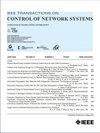Privacy-Preserving Distributed Extended Kalman Filtering for Graphical Nonlinear Systems
IF 4
3区 计算机科学
Q2 AUTOMATION & CONTROL SYSTEMS
引用次数: 0
Abstract
In this article, a privacy-preserving distributed extended Kalman filter based on average consensus information fusion is designed for graphical nonlinear systems. The privacy-preserving approach adopted is realized based on a combination of state decomposition and noise injection methods. On the one hand, the Laplacian matrix of the graphical nonlinear system is utilized to design a distributed filter in the graph frequency domain, featuring a diagonal gain matrix that significantly enhances filtering performance; on the other hand, a recursive least squares filter is applied at the sensor nodes to filter out the privacy-preserving noise, thus making the eavesdropper's observation mismatch with the iterative update of the sensor state, which effectively improves the filtering and privacy performance. Subsequently, the boundedness of the filtering error is shown, and the privacy performance against eavesdroppers is discussed. Finally, a simulation example of a power system demonstrates the superiority of our proposed algorithm.非线性图形系统的隐私保护分布扩展卡尔曼滤波
针对图形非线性系统,设计了一种基于平均一致性信息融合的保隐私分布式扩展卡尔曼滤波器。所采用的隐私保护方法是基于状态分解和噪声注入相结合的方法实现的。一方面,利用图形非线性系统的拉普拉斯矩阵在图频域设计分布式滤波器,该滤波器具有对角增益矩阵,显著提高了滤波性能;另一方面,在传感器节点上采用递归最小二乘滤波器滤除隐私保护噪声,使窃听者的观测与传感器状态的迭代更新不匹配,有效提高了滤波性能和隐私性能。随后,给出了过滤误差的有界性,并讨论了对窃听者的隐私性能。最后,通过电力系统的仿真实例验证了该算法的优越性。
本文章由计算机程序翻译,如有差异,请以英文原文为准。
求助全文
约1分钟内获得全文
求助全文
来源期刊

IEEE Transactions on Control of Network Systems
Mathematics-Control and Optimization
CiteScore
7.80
自引率
7.10%
发文量
169
期刊介绍:
The IEEE Transactions on Control of Network Systems is committed to the timely publication of high-impact papers at the intersection of control systems and network science. In particular, the journal addresses research on the analysis, design and implementation of networked control systems, as well as control over networks. Relevant work includes the full spectrum from basic research on control systems to the design of engineering solutions for automatic control of, and over, networks. The topics covered by this journal include: Coordinated control and estimation over networks, Control and computation over sensor networks, Control under communication constraints, Control and performance analysis issues that arise in the dynamics of networks used in application areas such as communications, computers, transportation, manufacturing, Web ranking and aggregation, social networks, biology, power systems, economics, Synchronization of activities across a controlled network, Stability analysis of controlled networks, Analysis of networks as hybrid dynamical systems.
 求助内容:
求助内容: 应助结果提醒方式:
应助结果提醒方式:


